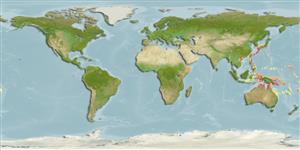>
Blenniiformes (Blennies) >
Blenniidae (Combtooth blennies) > Salariinae
Etymology: Praealticus: Latin, prae = in front of + Latin, altus, alticus = nutritious.
Eponymy: This is a toponym referring to Tanegashima, Osumi Islands, Japan, type locality [note spelling, without “h”]. (Ref. 128868), visit book page.
More on authors: Jordan & Starks.
Environment: milieu / climate zone / depth range / distribution range
Ökologie
seewasser demersal. Tropical
Western Pacific: southern Japan, Taiwan, and Guam.
Size / Gewicht / Alter
Maturity: Lm ? range ? - ? cm
Max length : 5.9 cm SL Männchen/unbestimmt; (Ref. 28618)
Rückenflossenstacheln (insgesamt) : 13; Rückenflossenweichstrahlen (insgesamt) : 17 - 19; Afterflossenstacheln: 2; Afterflossenweichstrahlen: 18 - 19. Nasal cirrus simple and supraorbital cirrus long, a little pinnate. Nuchal cirrus absent. Occipital crest in male, none in female. Some oblique lines distinct on cheek.
Facultative air-breathing (Ref. 126274); Adults inhabit surge, rocky shore areas. Grow to less than 14 cm TL. Oviparous. Eggs are demersal and adhesive (Ref. 205), and are attached to the substrate via a filamentous, adhesive pad or pedestal (Ref. 94114). Larvae are planktonic, often found in shallow, coastal waters (Ref. 94114).
Life cycle and mating behavior
Geschlechtsreife | Fortpflanzung | Ablaichen | Eier | Fecundity | Larven
Oviparous, distinct pairing (Ref. 205).
Masuda, H., K. Amaoka, C. Araga, T. Uyeno and T. Yoshino, 1984. The fishes of the Japanese Archipelago. Vol. 1. Tokai University Press, Tokyo, Japan. 437 p. (text). (Ref. 559)
IUCN Rote Liste Status (Ref. 130435: Version 2024-1)
Bedrohung für Menschen
Harmless
Nutzung durch Menschen
Tools
Zusatzinformationen
Download XML
Internet Quellen
Estimates based on models
Preferred temperature (Ref.
123201): 20.7 - 28.5, mean 25.4 °C (based on 257 cells).
Phylogenetic diversity index (Ref.
82804): PD
50 = 0.5001 [Uniqueness, from 0.5 = low to 2.0 = high].
Bayesian length-weight: a=0.01047 (0.00461 - 0.02381), b=2.98 (2.79 - 3.17), in cm total length, based on LWR estimates for this (Sub)family-body shape (Ref.
93245).
Trophic level (Ref.
69278): 2.0 ±0.00 se; based on food items.
Widerstandsfähigkeit (Ref.
120179): hoch, Verdopplung der Population dauert weniger als 15 Monate. (Preliminary K or Fecundity.).
Fishing Vulnerability (Ref.
59153): Low vulnerability (10 of 100).
